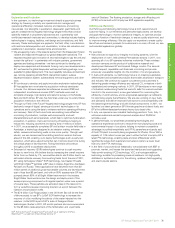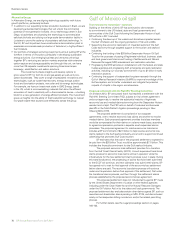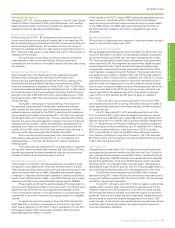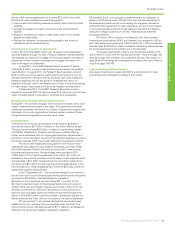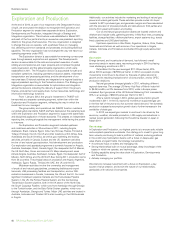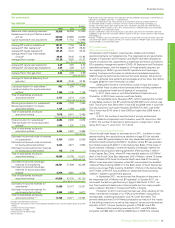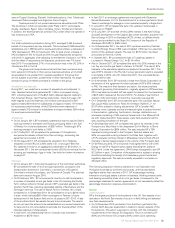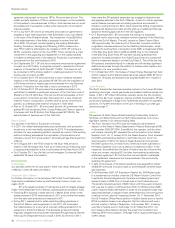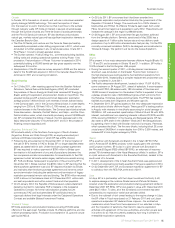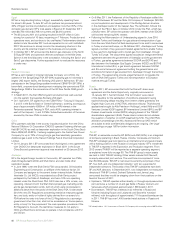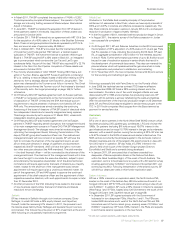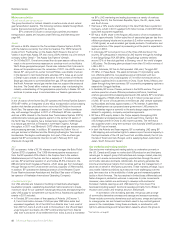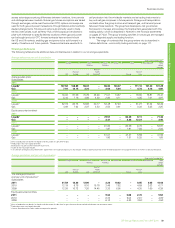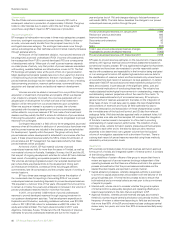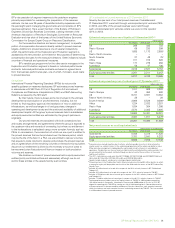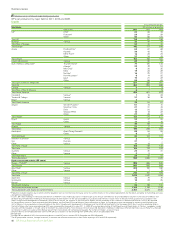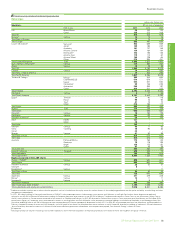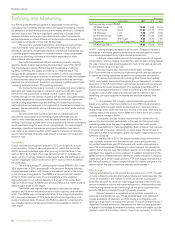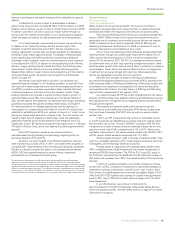BP 2011 Annual Report Download - page 87
Download and view the complete annual report
Please find page 87 of the 2011 BP annual report below. You can navigate through the pages in the report by either clicking on the pages listed below, or by using the keyword search tool below to find specific information within the annual report.
BP Annual Report and Form 20-F 2011 85
Business review: BP in more depth
Business review
Canada
In Canada, BP is focused on oil sands, and will use in situ steam-assisted
gravity drainage (SAGD) technology. This uses the injection of steam
into the reservoir to warm the bitumen so that it can flow to the surface
through recovery wells. BP holds an interest in several oil sands leases
through the Sunrise oil sands and Terre de Grace oil sands partnerships
and the Pike Oil Sands joint venture. BP also develops and produces
natural gas, markets natural gas and has significant exploration interests in
the Canadian Beaufort Sea.
• The Pike Oil Sands joint venture and the Terre de Grace partnership
successfully completed winter drilling programmes in 2011, which were
conducted to further appraise in situ oil sands resources. In late 2011,
Pike Phase 1 moved to project appraisal status.
• The Sunrise operator, Husky Energy Inc., commenced building facilities,
drilling wells and creating operational systems to bring Phase 1 into
production. First production of Phase 1 bitumen is expected in 2014,
potentially building to 60,000 barrels per day gross capacity over the
subsequent 24 months.
• Interpretation of the 3D seismic survey acquired in 2009 and the seismic
data for the EL446 field acquired in 2010 in the Canadian Beaufort Sea
continued in 2011 and is nearing completion.
South America
Brazil
• On 12 May 2011, after receiving approval from the Brazilian National
Petroleum, Natural Gas and Biofuels Agency (ANP), BP concluded
the purchase of Devon Energy do Brasil (later renamed BP Energy do
Brasil), adding 10 exploration and production blocks to its portfolio. The
acquired blocks give BP a diverse and broad deepwater exploration
acreage position offshore Brazil, with interests in seven licence blocks
in the Campos basin, one in the Camamu-Almada basin in water depths
ranging from 330 to 9,100 feet (100 to 2,780 metres), as well as two
onshore licences in the Parnaíba basin. The Campos basin blocks include
three discoveries – Xerelete, Pre-Salt Wahoo, and Itaipú – and the Polvo
Field in shallow water, which is currently producing around 19,000boe/d
net. BP completed the drilling of Itaipú-2, the first appraisal well in the
Itaipú deepwater discovery in November 2011 and is in the process of
finishing a second appraisal well.
Argentina, Bolivia and Chile
BP conducts activity in the Southern Cone region of South America
(Argentina, Bolivia and Chile) through PAE, an equity-accounted joint
venture with Bridas Corporation in which BP has a 60% interest.
• Following the announcement in November 2011 of the termination of
the sale of BP’s interest in PAE to Bridas, BP no longer classifies these
assets as assets held for sale. Under the share purchase agreement
BP was required to make a payment of $700 million to Bridas upon
termination in full settlement of any and all past claims between the
two companies and also as consideration for amendments to the PAE
agreement which terminate certain legacy restrictive covenants among
BP, PAE and Bridas. Subsequent to payment of this amount by BP in
November 2011, Bridas returned this $700 million to BP claiming that the
share purchase agreement was void; BP disputes this claim by Bridas
and maintains that the share purchase agreement and its terms which
survive termination (including the settlement and termination of legacy
restrictive covenants) remain valid and binding. The $700 million returned
to BP is shown in the balance sheet at 31 December 2011 within cash
and cash equivalents and within current trade and other payables.
• On 24 January 2012, the Republic of Bolivia issued a press statement
declaring its intent to nationalize PAE’s interests in the Caipipendi
Operations Contract. No formal nationalization process has yet
commenced. PAE and its shareholders BP and Bridas intend to
vigorously defend their legal interests under the Caipipendi Operations
Contract and available Bilateral Investment Treaties.
Trinidad & Tobago
BP holds exploration and production licences covering 917,000 acres
offshore of the east coast. Facilities include 13 offshore platforms and one
onshore processing facility. Production is comprised of oil, gas and natural
gas liquids (NGLs).
• On 25 July 2011, BP announced that it had been awarded two
deepwater exploration and production blocks by the government of the
Republic of Trinidad & Tobago. The award was for a 100% interest in
blocks 23(a) and TTDAA 14 offshore Trinidad’s east coast, both under
PSAs. Government approval is expected in early 2012. These blocks will
increase the acreage in the region by 889,000 acres.
• On 26 August 2011, BP announced that first gas had been achieved
from the Serrette platform. Serrette, sanctioned in May 2009, has a
design capacity of 1 billion cubic feet per day and may deliver a peak
production of up to 500 million standard cubic feet per day. It is the fifth
normally unmanned installation (NUI) to be designed and constructed in
Trinidad & Tobago. The platform will tie into the Cassia B platform.
Africa
Angola
BP is present in four major deepwater licences offshore Angola (Blocks 15,
17, 18 and 31) and is operator in Blocks 18 and 31. In addition, BP holds a
13.6% interest in the first Angolan LNG project.
• During the second quarter of 2011, a 40-day planned maintenance
shutdown was conducted on the Greater Plutonio field. Corrosion in
the high pressure gas cooling systems had restricted operations from
September 2010, necessitating a complex replacement project that was
safely completed in June 2011.
• The Pazflor deepwater development, located in block 17 (BP 16.67%),
came onstream on 24 August 2011, ahead of schedule. It encompasses
a new build FPSO, 49 subsea wells, 180 kilometres of flowlines and
10,000 tonnes of equipment on the seabed. Pazflor is expected to have
a plateau production rate of 220,000boe/d gross which will come from
the Perpetua, Hortensia, Acacia and Zinia fields. The FPSO has topside
facilities to process both Oligocene and Miocene age oils.
• In December 2011, BP gained access to five new deepwater exploration
and production blocks offshore Angola. These gave BP a leading position
in Angola, with interests in nine blocks accounting for a total acreage of
30,842km2. BP was awarded operatorship of Blocks 19 and 24 with 50%
interest, and additional non-operating interests in Blocks 20 (20%) and 25
(15%) covering 19,400km2 in the Kwanza and Benguela basins. BP has
also taken a 40% stake in the 4,840km2 Block 26 in the Benguela basin,
by agreeing a farm-in deal with Brazilian national oil company, Petrobras,
which operates the block. The five new blocks, including block 26, cover
a total area of 24,000km2 in water depths from 200 to 2,500 metres, and
increase BP’s total Angolan acreage by 275%.
Algeria
BP is a partner with Sonatrach and Statoil in the In Salah (BP 33.15%)
and In Amenas (BP 45.89%) projects, which supply gas to the domestic
and European markets. BP is also in a joint venture with Sonatrach in
the Rhourde El Baguel (REB) oilfield (BP 60%), an enhanced oil recovery
project 75 kilometres east of the Hassi Messaoud oilfield. In addition, BP is
in a joint venture with Sonatrach in the Bourarhet Sud block, located to the
south west of In Amenas.
• In 2011, development of the In Salah Southern Fields was approved and
the primary engineering contracts awarded. First gas is expected in 2014.
• On 22 December 2011, BP and Sonatrach reached an agreement for BP
to withdraw from the REB PSA at the end of 2011.
Libya
In Libya, BP is in partnership with the Libyan Investment Authority (LIA)
to explore acreage in the onshore Ghadames and offshore Sirt basins,
covered under the exploration and production-sharing agreement ratified in
December 2007 (BP 85%). BP’s total assets in Libya at 31 December 2011
were $437 million. To date, all of the 3D seismic commitment has been
completed but no exploration wells have yet been drilled.
• Due to the outbreak of civil unrest leading to the regime change in Libya,
the BP office in Tripoli was closed on 21 February 2011 and our Libyan
operations suspended. BP declared force majeure – the contractual
mechanism which flows from the suspension of our activities in Libya
and the imposition of sanctions. We intend to resume exploration
activities with agreement of the new authorities, and when we are sure
it is safe to do so. We are currently assessing how long it will take to
re-establish exploration operations.


